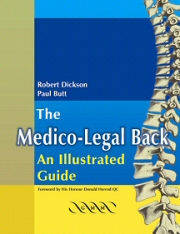3 - Biomechanics of the Spine
Published online by Cambridge University Press: 10 December 2009
Summary
To support the body and provide a wide range of motion while protecting the spinal cord demands stable movements and the prevention of instability and the spine is brilliantly designed for these purposes. It is a column comprising a series of bone segments (vertebrae) separated by discs and joined by ligaments so that considerable movement of the whole is produced by relatively small displacements at many sites rather like a bicycle chain. This is a much more stable configuration than motion occurring at few very mobile joints as in the limbs. Notwithstanding, the spine can be damaged.
The ability of a structure to resist breakage depends upon two things – its shape (geometry) and what it is made of (materials) and bones including vertebrae are no exceptions.
Most matters that concern doctors and lawyers in personal injury or medical negligence are to do with the effects of trauma, which is what happens to the body in response to an applied load, and, therefore, it is necessary to become familiar with some of the more important biomechanical words and phrases. We have already seen that when something is squashed, it is under compression; and when something is stretched, it is under tension. Compression and tension are, therefore, forces applied along the length of the material. The third type of force, shear, is applied to the side of the material at right angles to the long axis, rather like rubbing something.
Compression – squeezing
Tension – stretching
Shear – rubbing
- Type
- Chapter
- Information
- The Medico-Legal Back: An Illustrated Guide , pp. 37 - 52Publisher: Cambridge University PressPrint publication year: 2003



